
This lab will give you a chance to practice working with an analytical balance. You will weigh four items to check the balance response at its midpoint.
- Subject:
- Allied health personnel
- CTE
- Material Type:
- Unit of Study
- Date Added:
- 09/11/2018

This lab will give you a chance to practice working with an analytical balance. You will weigh four items to check the balance response at its midpoint.
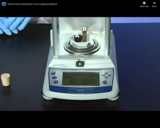
A balance calibrated at zero grams and 100 grams should give accurate readings at those extremes and also at 35 g, 50 g, or any other point in between. Linearity error can cause a balance to be less accurate in one part of its range than in another part. This video demonstrates the procedure for checking the linearity of an analytical balance.
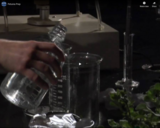
Composites play a major role in the construction of modern aircraft.

You've just been hired as a quality assurance inspector for a research testing company. Your job is to talk to employees in the aliquoting department and identify pipetting-related CAPA, Corrective and Preventative Actions that your company should take.
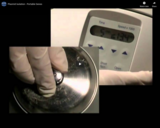
This experiment demonstrates the existence of plasmid DNA in E. coli cells.

Reducing errors in claims is a huge part of the medical billing process. In this course, we'll introduce you to some of the most common errors you can make on a claim.
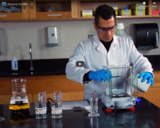
Tris is a buffer that's used to maintain a stable pH when working with solutions in the lab. In this video, we'll demonstrate the steps for preparing 250 mL of a 0.5 molar Tris buffer. We'll measure our powder, mix it with water using a stir plate, and then test our pH with a pH meter. We'll add drops of hydrochloric acid to lower the pH to our target of 7.8.
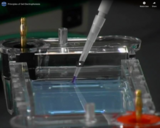
This video is a walkthough of principles of gel electrophoresis.
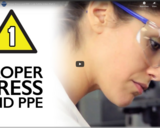
The first consideration is proper dress. What you wear in the lab can help prevent serious, even fatal injuries. You'll also need PPE - Personal Protective Equipment. For general lab work, a lab coat, safety glasses or goggles, and gloves are required. The lab environment is hazardous by nature. The actual risk is largely determined by you and those working with you. It's your responsibility to know and follow the rules and be able to recognize potential safety hazards.
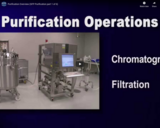
There are two main operations used within purification: Chromatography and Filtration. Our GFP process is pretty typical for biopharmaceutical products. The clarified lysate is pre-filtered, goes through Anion Exchange Chromatography, and then collected and pooled. Next, Ammonium sulfate is added to make the solution high-salt followed by Hydrophobic Interaction Chromatography. The GFP is then collected and pooled again. The solution then goes through a TFF ultrafiltration step – which includes concentration of the GFP followed by Diafiltration to exchange buffer solutions and remove salt. And the process finishes up with Final Filtration into bulk bottles or bags The Purification process is managed through the use of a Batch Process Record. These documents lead the operator step-by-step...and require a sign-off and verification by a second operator. The Purification area must be cleaned, disinfected and organized. Any unneeded equipment or materials are removed. All required materials and documentation must be gathered and prepared before the process may begin.
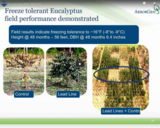
Panelist: Maud A Hinchee, PhD Scientific advances are unlocking ever more significant uses for the components of trees. In addition to the wood, pulp for paper and wood for fire, increasing demands are being made of trees for fine grade cellulosic sugars that can be converted to biofuels, polyethylene and other compounds for industrial use. Yet the tree itself remains an undomesticated plant. Far from its agricultural counterparts which have been bred for cold tolerance, drought resistance, improved yields and improved food quality, the tree has only been bred for a few generations and predominately to improve form for processing lumber. ArborGen uses advance breeding techniques to shorten the time required to reach domesticated species for industrial purposes. Varietal propagation allows us to replicate one species to improve consistency. Mass Controlled Pollination allows us to improve a line by controlling one parent in a breeding pair. However, demands for wood cellulose are growing at a rate of acceleration that can never be matched at the conventional breeding level for a species that takes more than 20 years to mature. ArborGen scientists use precision breeding techniques to look at specific ways of improving and domesticating trees for industrial uses. One excellent example is a lignin-modified Eucalpytus species that has proven to release more than twice the usual amount of sugar, making it a promising option as a biomass feedstock for liquid fuel. The tree is being studied by National Renewable Energy Lab (NREL). Another example is a Freeze Tolerant Eucalyptus that can be grown in the Southeast United States to provide a sustainable supply of hardwood fiber to meet the needs of the pulp, paper and bioproducts industries.
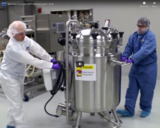
So how does Recovery work - and how does it fit into the total production flow? Here's a very basic overview. After Fermentation is complete, the broth is harvested and sent to Recovery. Here the E.coli host cells are separated from the liquid broth, then suspended in a new solution to wash the cells...Separated again...Resuspended in a new solution...Homogenized to break open the cells...and the cell debris is removed. Once Recovery is complete, the product is sent to Purification to be refined and concentrated.
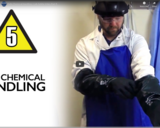
It's vital that you prepare for each lab activity by determining the possible risks, donning the right PPE, and be aware of any protective measures and emergency responses that are pertinent for the chemicals that you'll be working with. , Eye protection , Transporting chemicals , Lab aprons and arm-length rubber gloves , Inhalation exposure , Chemical spill response , Flammables , Chemical disposal
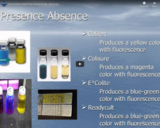
Panelists: Jesse Chadwick & Julius Patrick of Greenville Utilities The life science industry is one of many that depend heavily on clean, good quality, potable (drinking) water supplied from municipal water systems. In fact, we all rely on clean, safe water. One of our most valuable resources is clean drinking water. As our society has changed so have sources of clean drinking water. In this presentation we will discuss different technologies and treatments used at surface water treatment plants to provide safe drinking water along with current and future standards for water quality.
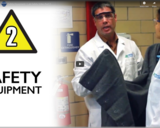
In this lesson, we'll talk about safety equipment found in the lab. , Safety shower and eye wash station , Fire extinguisher , Fire blanket , First aid kit , Evacuation route , Chemical fume hood These items may help you save a life - if and when - an accident occurs.

A sample of modified E-coli is taken from the freezer and thawed. It's used to inoculate a small amount of fresh media in a shaker flask. The media provides the nutrition the cell needs to grow. When the cells have grown and consumed most of the nutrients, they're transferred to a larger vessel with more growth media, and the process repeats...This scaling-up is complete when the number of cells is large and healthy enough to transfer into a production vessel – often we call that a bioreactor or fermenter.

In science, it is not unusual for us to use either very large or very small numbers in our measurements and equations. Before the advent of calculators, we used scientific or exponential notation to simplify handling these very large or very small numbers.

Prepare for our Section 3 Quiz with this Section 3 Review. This video will go back over the key points of this section.
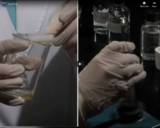
A composite is made by the combination of two or more materials to make a new material. Composites are carefully designed so that the desired properties, such as strength, weight, durability, flexibility, conductivity, and stability are improved. Composites are found all around us in our daily lives
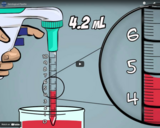
Serological pipettes are used for measuring and transferring volumes of solution. Your technique must be exact to ensure accurate measurements and to avoid introducing contamination.